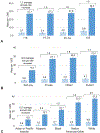Recorded Diagnoses of Depression During Delivery Hospitalizations in the United States, 2000-2015
- PMID: 31135737
- PMCID: PMC6842065
- DOI: 10.1097/AOG.0000000000003291
Recorded Diagnoses of Depression During Delivery Hospitalizations in the United States, 2000-2015
Abstract
Objective: To describe national, state-specific, and sociodemographic trends in diagnoses of depressive disorders recorded during delivery hospitalizations.
Methods: Data were analyzed from the National Inpatient Sample (2000-2015) and 31 publicly available State Inpatient Databases (2000-2015) of the Healthcare Cost and Utilization Project. Delivery hospitalizations were identified by using International Classification of Diseases, 9th Revision, Clinical Modification (ICD-9-CM) diagnostic and procedure codes for obstetric delivery. Depressive disorders were identified from ICD-9-CM diagnoses codes classified as depressive disorders in the Diagnostic and Statistical Manual of Mental Disorders, 5th Edition (291.89, 292.84, 293.83, 296.2-296.26, 296.3-296.36, 300.4, and 311). Prevalence rates and average annual rate change were calculated nationally and across 28 states with at least 3 years of data and age, payer source, and race or ethnicity.
Results: The U.S. rate of depressive disorders recorded during delivery hospitalizations increased from 4.1 diagnoses per 1,000 hospitalizations in 2000 to 28.7 in 2015. Rates significantly increased in 27 of the 28 states. Recent (2014-2015) rates were lowest in Hawaii and Nevada (less than 14/1,000) and highest in Vermont, Minnesota, Oregon, and Wisconsin (greater than 49/1,000). Rates in 2015 were highest among those aged 35 years or older, public insurance recipients, and non-Hispanic white women (greater than 31/1,000). The highest annual rate increases were in Vermont and Maine (3.8/1,000 or greater). Non-Hispanic white women, those 35 years of age or older, and public insurance recipients showed the highest annual rate increases during 2000-2015 (1.7/1,000 or greater).
Conclusion: During 2000-2015, rates of depressive disorders recorded during delivery hospitalizations increased nationally, in 27 states with available data, and across all sociodemographic categories.
Figures



References
-
- Gavin NI, Gaynes BN, Lohr KN, Meltzer-Brody S, Gartlehner G, Swinson T. Perinatal depression: a systematic review of prevalence and incidence. Obstet Gynecol 2005;106:1071–83. - PubMed
-
- Zuckerman B, Amaro H, Bauchner H, Cabral H. Depressive symptoms during pregnancy: Relationship to poor health behaviors. Am J Obstet Gynec 1989;160:1107–11. - PubMed
-
- Chung TKH, Lau TK, Yip ASK, Chiu HFK, Lee DTS. Antepartum depressive symptomatology is associated with adverse obstetric and neonatal outcomes. Psychosom Med 2001;63:830–4. - PubMed
-
- Kurki T, Hiilesmaa V, Raitasalo R, Mattila H, Ylikorkala O. Depression and anxiety in early pregnancy and risk for preeclampsia. Obstet Gynecol 2000;95:487–90. - PubMed
MeSH terms
Grants and funding
LinkOut - more resources
Full Text Sources
Medical

